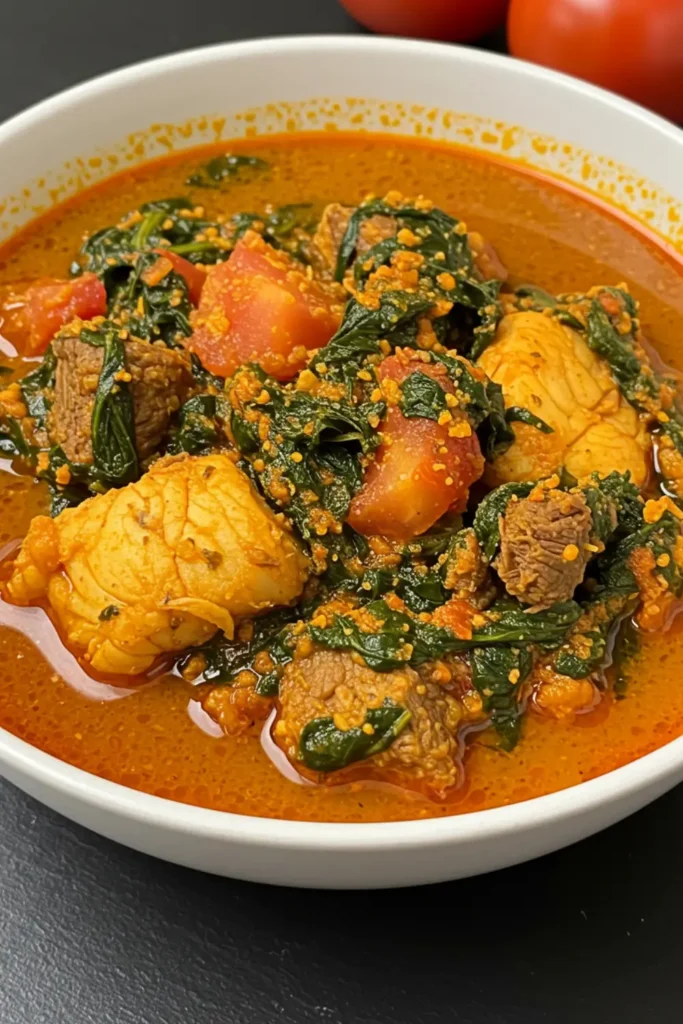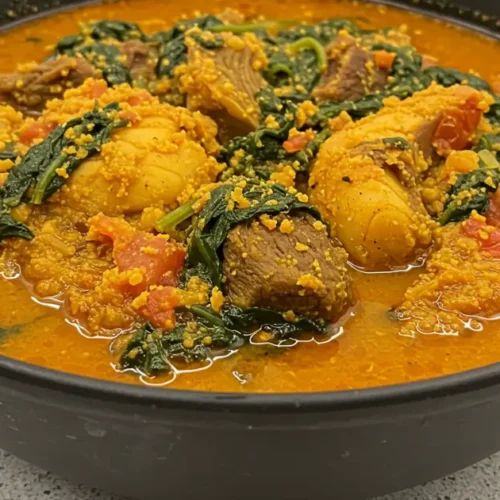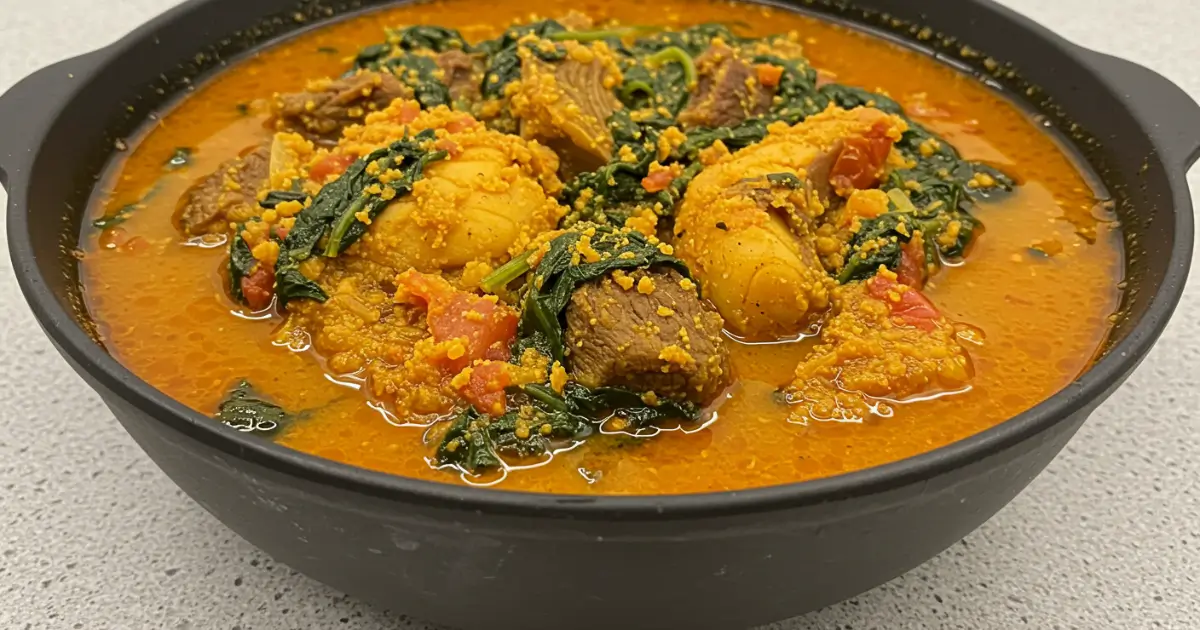Ground melon seeds (egusi) – The key ingredient in egusi soup, giving it its signature creamy texture and nutty flavor.
Leafy greens (spinach, bitter leaf, or ugu) – These add vibrant color and a fresh, earthy taste to the soup.
Palm oil – Essential for the rich, red color and deep flavor base of the soup.
Meat (beef, goat meat, or chicken) – Adds a hearty, savory element to the soup. You can also use fish like stockfish or dried fish for added depth.
Onions – Brings a mild sweetness and savory richness when sautéed.
Tomatoes – Adds a fresh, tangy contrast to balance the richness of the soup.
Seasonings (bouillon cubes, salt, pepper) – Enhances the flavor profile, bringing everything together without overpowering the dish.
Egusi soup is more than just a dish—it’s a flavorful, comforting meal with a rich cultural history. For many, especially those with roots in West Africa, it brings back memories of family gatherings and celebrations. Whether you’re familiar with this Nigerian favorite or new to it, this guide will show you everything you need to know about egusi soup: its ingredients, how to make it, variations, and helpful tips to perfect your recipe.
Why We Love This
Egusi soup is more than just a meal—it’s an experience. From the first spoonful, you’ll notice the combination of flavors, textures, and cultural significance that make this soup stand out. Here’s why it’s loved by many:
- Rich Flavor Profile: The soup is made from ground melon seeds, known as egusi, which give it a nutty, slightly earthy taste. Combined with meats, vegetables, and spices, it creates a deliciously layered flavor profile that is both savory and satisfying.
- Nutrient-Dense: This soup isn’t just a treat for your taste buds; it’s packed with protein, fiber, and essential nutrients. The melon seeds themselves provide a good source of healthy fats and protein, while the leafy greens offer vitamins and minerals that contribute to overall well-being.
- Versatility: Egusi soup can be adapted to suit your preferences. You can choose the meats or even opt for a vegetarian version using hearty vegetables. It’s a versatile dish that can be enjoyed by everyone.
- Cultural Significance: In Nigerian households, egusi soup is more than just a dish—it’s a tradition. It’s often made during holidays, family gatherings, and special celebrations, making it a meal that brings people together.
- Easy to Make: While it might seem intimidating at first, making egusi soup is relatively straightforward, especially when you have the right ingredients and a little guidance. The steps are simple, and with some patience, you’ll have a delicious, authentic dish to enjoy.

Ingredients
To make a truly authentic egusi soup, it’s important to have the right ingredients. Here’s a breakdown of the essentials that you’ll need:
Ground melon seeds (egusi) – The key ingredient in egusi soup, giving it its signature creamy texture and nutty flavor.
Leafy greens (spinach, bitter leaf, or ugu) – These add vibrant color and a fresh, earthy taste to the soup.
Palm oil – Essential for the rich, red color and deep flavor base of the soup.
Meat (beef, goat meat, or chicken) – Adds a hearty, savory element to the soup. You can also use fish like stockfish or dried fish for added depth.
Onions – Brings a mild sweetness and savory richness when sautéed.
Tomatoes – Adds a fresh, tangy contrast to balance the richness of the soup.
Seasonings (bouillon cubes, salt, pepper) – Enhances the flavor profile, bringing everything together without overpowering the dish.
How to Make Egusi Soup
Making egusi soup may seem like a big task, but once you break it down step-by-step, it becomes quite simple. Here’s how you can make a mouthwatering pot of egusi soup:
Step 1: Prep the Ingredients
Start by grinding your egusi seeds into a fine powder. You can either do this yourself or buy pre-ground egusi from your local store. Cut your meat into bite-sized pieces and wash the greens thoroughly. Having everything prepped will make the cooking process smooth and efficient.
Step 2: Cook the Meat
In a large pot, add your assorted meats (beef, goat, chicken, or tripe) along with any stockfish. Pour in enough water to cover the meat and bring it to a boil. Add your seasonings (bouillon cubes, salt, and half of the ground pepper) and let it cook for 30-40 minutes until the meat is tender and the flavors have melded together. Skim off any excess fat or scum that rises to the surface during cooking.
Step 3: Prepare the Egusi Paste
While the meat is cooking, heat your palm oil in a separate pan over medium heat. If you’re using onions, sauté them in the oil until they become soft and translucent. Add the ground egusi paste, stirring continuously to avoid lumps. Add a little water to the paste and continue stirring until it becomes thick and smooth.
Step 4: Combine the Meat and Egusi
Once your meat is tender, carefully add the egusi paste to the pot with the meat. Stir the mixture well to combine, ensuring that the egusi paste is fully incorporated into the broth. Allow it to cook for about 10-15 minutes. The egusi will begin to thicken and create a rich base for your soup.
Step 5: Add the Greens and Final Seasoning
Add your chopped greens to the pot. Stir the soup and let it simmer for another 10-15 minutes. This will allow the flavors to meld together and the greens to cook down. Taste your soup and adjust the seasoning by adding more salt or pepper, if needed.
Step 6: Adjust Consistency and Serve
Finally, check the consistency of your soup. If it’s too thick, add a bit more water or broth until it reaches your desired texture. Let it simmer for a few more minutes, then taste one last time to ensure the seasoning is just right.
Expert Tips: Perfecting Your Egusi Soup
To make sure your egusi soup turns out perfect every time, here are some expert tips:
Use Fresh Palm Oil: For the best flavor, always use fresh, high-quality palm oil. It will give the soup that authentic taste and vibrant color that makes it so appealing.
Adjust the Consistency: If you like your soup thicker, reduce the amount of water you add. For a lighter, more soup-like consistency, feel free to add extra broth or water.
Don’t Skip the Crayfish: Ground crayfish is a key ingredient in egusi soup. It adds a savory, umami flavor that enhances the overall taste. Make sure to use it!
Cook Slowly: Allow the soup to cook slowly and let the flavors develop. The longer it simmers, the better the taste.
Variations: Personalize Your Egusi Soup
One of the best things about egusi soup is how adaptable it is. You can make it your own by playing with different ingredients and variations:
Vegetarian Version: If you prefer a plant-based diet or just want to try something different, you can make a vegetarian egusi soup using mushrooms, sweet potatoes, and other hearty vegetables instead of meat.
Seafood Egusi Soup: For a different twist, you can replace the meats with seafood like shrimp, fish, or lobster. The seafood will bring a fresh, oceanic flavor that pairs wonderfully with the earthy egusi.
Spicy Egusi Soup: If you love heat, increase the amount of hot pepper or use a variety of chili peppers to spice things up. You can also add a little more ground pepper for an extra kick.
Serving Egusi Soup
Egusi soup is best enjoyed with a delicious, starchy side that helps balance its rich, savory flavors. Here are some popular options:
Pounded Yam: This is the classic side dish for egusi soup. The smooth, stretchy texture of pounded yam makes it perfect for scooping up the soup.
Eba: Made from garri (cassava flour), eba is another popular accompaniment. It’s slightly firmer than pounded yam and adds a nice contrast to the soup’s richness.
Fufu: Fufu, made from fermented cassava, has a slightly tangy flavor that pairs beautifully with the savory soup.
Rice or Plantains: If you want something different, try serving egusi soup with rice or fried plantains for a fun twist on this classic dish.
FAQs About Egusi Soup
What is Egusi Soup Made Of?
Egusi soup is made from ground melon seeds (egusi), meats (such as beef, goat, or chicken), leafy vegetables, and seasonings. It’s a rich, savory soup that is a staple in Nigerian cuisine.
How Do You Thicken Egusi Soup?
To thicken egusi soup, ensure that the egusi paste is thick enough before adding it to the pot. You can also reduce the amount of water you add for a thicker consistency.
What Goes Well with Egusi Soup?
Egusi soup pairs well with traditional Nigerian sides like pounded yam, eba, fufu, or even rice. These starchy sides complement the richness of the soup.
Can You Make Egusi Soup in Advance?
Yes! Egusi soup actually tastes better the next day as the flavors develop further. Store any leftovers in an airtight container for up to 3 days in the fridge.
What Are Some Variations of Egusi Soup?
Egusi soup can be made with various meats, seafood, or even a vegetarian version. Some may also use different greens or increase the spiciness for a personalized twist.

Egusi Soup
Equipment
- Large Pot
- Pan
Ingredients
- 2 cups Egusi (Melon Seeds)
- 1-2 lbs Meat (Beef, Goat, Chicken, or Tripe)
- as desired Stockfish
- 2 cups Leafy Greens (Spinach or Ugu)
- 2 tablespoons Ground Crayfish
- 1 tablespoon Ground Pepper
- 1-2 Bouillon Cubes
- to taste Salt
- 1/4 cup Palm Oil
- as needed Water or Broth
- 1 Onion (Optional)
Instructions
- Grind the egusi seeds into a fine powder. Cut the meat into bite-sized pieces and wash the leafy greens thoroughly.
- In a large pot, cook the meats and stockfish in water. Add bouillon cubes, salt, and half of the ground pepper. Let it simmer for 30-40 minutes until the meat is tender.
- In a separate pan, heat palm oil and sauté onions (if using) until translucent. Add the ground egusi paste, stirring continuously to avoid lumps. Add water to make the paste smooth and thick.
- Once the meat is tender, add the egusi paste to the pot. Stir well to combine and cook for 10-15 minutes to allow the flavors to meld together.
- Add the chopped greens to the pot and simmer for another 10-15 minutes. Taste and adjust the seasoning if necessary.
- If the soup is too thick, add more water or broth to achieve the desired consistency. Let it cook for a few more minutes, then serve.
Send me this recipe!
Just enter your email below and get it sent straight to your inbox!


